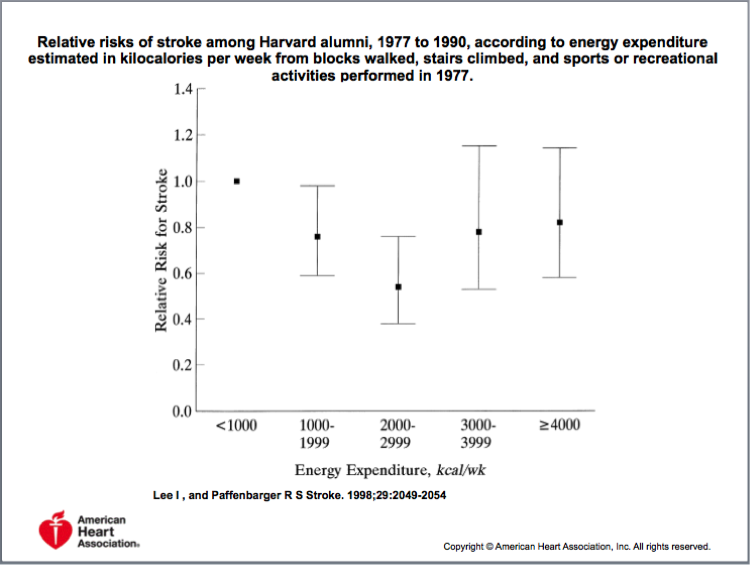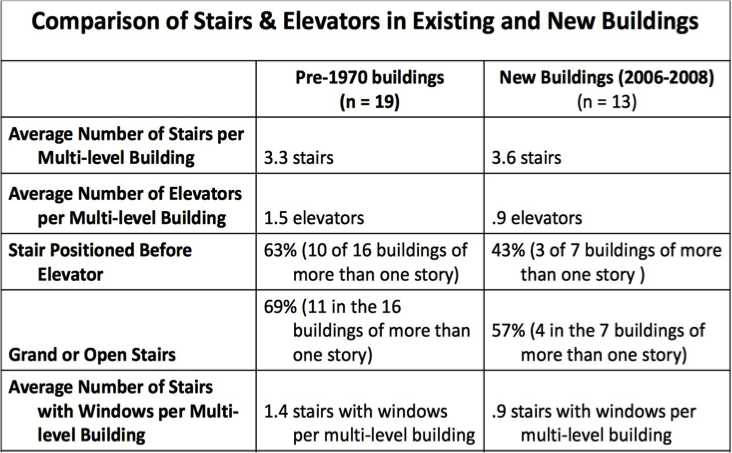
Taking the Stairs To Prevent Stroke & Heart Disease
It Might Be Easier Than You Think
How often in a typical day do you even come close to breaking a sweat? What about feeling your heart beat noticeably faster or your breathing rate increase? If your answer is, “not very often”, then you are in good company. Less than 48 percent of American adults meet the recommended physical activity guidelines administered by the CDC. These guidelines are very basic; they aren’t for people training for a marathon, just for the average human being who wants to maintain good health throughout their life.
Check on your health according to the CDC here.
The good news is there is a wide range of options in what constitutes healthful and helpful physical activity. If you took a brisk 25 minute walk to work or during lunchtime every day, you would end up on the right side of that 48/52 percent divide. But when you bump things up to the kind of activity that gets you breathing hard and a little burn in your thighs, you can cut that time in half. Most experts agree that the simplest way to do that on a daily basis is to start taking the stairs.
An Architect’s Solution
“There’s a lot of research that shows you only have to walk the stairs two minutes a day, to counter the average weight gain in a US adult,” said David Burney, former New York City commissioner of the Department of Design and Construction. “So the health benefit of that little bit of mobility is really important.”
Burney helped to create the Active Design Guidelines, a 140-page publication commissioned by the City to encourage architects, city planners and businesses to build in elements into new and renovated buildings that focus on health. One of the biggest focuses of those guidelines are architectural techniques that encourage people to forego enormous banks of high-speed elevators in favor of taking the stairs.
See all the Active Design Guidlelines here.
Venues like the Apple Store near Central Park, the new Cooper Union and the renovated New York Times building have showpiece staircases of unusual dimensions that utilize a lot of glass and a lot of natural and artificial light. By adding appealing light features, artistic design touches, visual art, even playing music in stairwells Burney believes that architects and interior designers can play an important part in forcing people towards the stairs, and into the cardiovascular benefits that such little bit of exercise can provide.
How Good Is It?
But just how good can stair-climbing be for you? A long-term study at Harvard University surveyed male alumni between ages 43-88 about their weekly exercise level and confirmed they maintained it annually. They compared that data with a second questionnaire eleven years later that assessed stroke occurrence. The results were more than merely conclusive.
Researchers found that men who expended energy at a light intensity level at longer durations (i.e. long walks several times a week) showed a decreased risk of stroke over time. Men who exercised at a moderate intensity level (i.e. climbing anywhere between 10-35 flights of stairs per week) saw an even further decrease in stroke risk, and men who climbed at least 8 flights per day were associated with a 33 percent lower mortality rate than men who were sedentary. Interestingly, there was a less significant decrease in stroke risk at activity levels HIGHER than this.

IM Lee. “Physical Activity and Stroke Incidence.” Harvard University, Cambridge MA. 1998, Link
This study stands as excellent evidence that you can do some of the best work for your long-term health at levels and durations that the average person, not just the Iron Man athlete, is comfortable maintaining. Pushing yourself to the furthest point you can bear has its merits and many of those are specific to the individual, but the best things you can do for the major tenants of your overall health are actually the more manageable forms of fitness, according to health experts.
Sports Medicine and Training on the Stairs
Amanda Winchester is a personal trainer and exercise instructor who teaches interval classes that combine moderate level cardio with short bursts with weights that target specific muscle groups. She is a big proponent of intervals on an uphill climb, a strategy she finds more of her students can handle without feeling ragged, but still does their bodies the most good.
“[Stairs] automatically increase the heart rate and increases blood flow to all major muscle groups. When you induce oxygen deprivation in those muscles you have to breath harder and harder in order to get your heart rate up, which leads to stronger heart muscles,” she said.
She consistently preaches the value of even very brief activity, that you can still do some real good during a busy day just by taking a couple flights of stairs. “Anytime you are getting your heart rate up you are going to be markedly increasing your health benefit. Even for a few minutes, it adds up.”
Dr. David Newton is a licensed chiropractor with a Master’s in Sports and Exercise Science; he specializes in treating athletes and other individuals who are already inclined to high levels of physical activity. But even he has many clients who misunderstand the value of even a few short minutes of getting your blood pumping, mainly because they are accustomed to the idea that when you are working out or training, you better be doing it with gusto. “It’s an excuse I hear all the time,” he said. “A lot of people don’t realize that if you can just climb the stairs for ten minutes during your work day, your body responds.”
New York City Responds
New York City’s government has responded as well. A significant portion of the Active Design Guidelines is designated to new ideas for spiffing up the stairs and encouraging people to use them, though it is somewhat unclear how much it is catching on.

Lee, Dr. Karen. Nicoll, Gayle. “Evaluating the Active Design Guidelines”. Active Living Research Conference. 2011, http://activelivingresearch.org/files/2011_Translating_Lee.pdf
In buildings built before 1970, there are 3.3 stairs in multi-level buildings on average compared to 3.6 in new buildings looked at between 2006 and 2008. Paired with that there is a decrease in the presence of elevators.
But the Active Design Guidelines were released widely to the public in 2011, so in many ways the jury is still out on that publication’s effectiveness. The data is definitive that staircases were pushed to the side and forgotten by architects for a lot of years in the past, but future studies may show a real shift back to a focus on the stairs. The City is requiring that all new public sector construction projects follow the guidelines, and many architects and designers sense a trend towards creating with people’s health at the forefront of their minds.
A New Trend Towards Health
“I think one of the most important things that is happening right now in architecture is connecting design inputs with health outcomes,” Karen Kubey, Executive Director of The Institute for Public Architecture said. She feels the profession and city governments nationwide are taking a renewed interest in building in ways that are conscious of the environment and public health, and that new buildings are beginning to show real results. “The better we can connect our work as architects with larger societal issues, including health, the better we can position ourselves to do good work.”
~By Anna Perczak